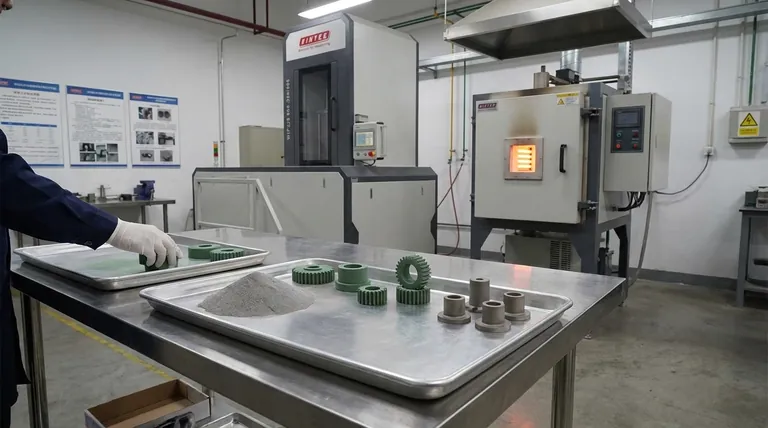In essence, powder metallurgy (PM) is a highly precise manufacturing process that creates solid metal components from metallic powders. Instead of melting metal into a liquid and casting it, PM involves compressing powder in a die and then heating it—without melting—to fuse the particles together into a strong, finished part. This method is fundamental for producing items like gears, bushings, and specialized structural components.
The core value of powder metallurgy is its ability to produce complex, net-shape parts with high precision and unique material properties, making it an efficient alternative to traditional casting or forging, especially for high-volume production.

The Core Process: From Powder to Part
Understanding powder metallurgy requires looking at its two primary stages: compaction and sintering. This sequence transforms loose powder into a dense, functional metallic component.
Compaction: Forming the "Green" Part
The process begins by pouring precisely engineered metal powder into a rigid die cavity. A press then applies extreme pressure, compacting the powder into a coherent shape.
This initial, fragile part is known as a "green compact." It has the desired shape and dimensions but lacks the final strength and integrity of the finished product.
Sintering: Fusing the Particles
The green compact is then moved to a controlled-atmosphere furnace for sintering. It is heated to a high temperature that is critically below the melting point of the primary metal.
This heat energy causes the individual powder particles to bond and diffuse into one another, eliminating pores and dramatically increasing the part's density, strength, and integrity.
Key Powder Characteristics
The success of the process depends on the quality of the starting powder. Engineers evaluate several factors, including:
- Flow Rate: Determines how quickly and evenly the die can be filled.
- Compressibility: The ability of the powder to densify under pressure.
- Green Strength: The strength of the part after compaction but before sintering.
Why Choose Powder Metallurgy?
PM is not just an alternative manufacturing method; it unlocks capabilities that are difficult or impossible to achieve with other processes.
Precision and Complex Geometries
Powder metallurgy excels at producing intricate and complex shapes with very tight tolerances, directly from the die. This "net-shape" capability often eliminates the need for expensive secondary machining operations.
Unique Material Capabilities
This process allows for the creation of unique materials. For example, it is used to make porous, self-lubricating bearings by intentionally leaving controlled porosity that can be impregnated with oil.
It is also the primary method for working with extremely high-melting-point materials like tungsten, which is used to create tungsten carbide cutting tools.
Efficiency in High-Volume Production
Once the tooling (the die) is created, PM can produce thousands or millions of identical parts with exceptional consistency and speed. This makes it highly cost-effective for large production runs of components like gears and structural parts.
Understanding the Trade-offs
While powerful, powder metallurgy is not the solution for every application. Objectivity requires acknowledging its limitations.
Lower Strength Than Forged Parts
While a sintered part is strong, it typically does not achieve the same ultimate tensile or fatigue strength as a part forged from a solid billet. The forging process aligns the metal's grain structure, resulting in superior toughness for high-stress applications.
Initial Tooling Costs
The hardened steel dies required for compaction are complex and expensive to manufacture. This high initial investment means PM is often not cost-effective for small production runs or prototypes.
Size and Design Constraints
The process is best suited for small- to medium-sized components. Very large parts are difficult to produce due to the immense pressures required for uniform compaction.
Making the Right Choice for Your Application
Selecting the correct manufacturing process depends entirely on your project's goals.
- If your primary focus is mass-producing complex parts with high precision: Powder metallurgy is a superior choice for minimizing waste and secondary machining.
- If your primary focus is creating materials with unique properties: PM is often the only viable method for producing porous filters, self-lubricating bearings, or parts from high-melting-point metals.
- If your primary focus is achieving the absolute highest mechanical strength and impact resistance: Forging remains the industry standard for critical, high-stress components.
By understanding its unique fusion of material science and manufacturing, you can leverage powder metallurgy to solve complex engineering challenges.
Summary Table:
| Aspect | Key Takeaway |
|---|---|
| Process | Compaction of metal powder followed by sintering (heating below melting point). |
| Key Advantage | Net-shape production of complex geometries, minimizing waste and machining. |
| Ideal For | High-volume production of parts like gears, bushings, and self-lubricating bearings. |
| Limitation | Generally lower strength than forged parts; high initial tooling cost. |
Ready to leverage the precision of powder metallurgy for your lab or production line?
KINTEK specializes in supplying the high-quality lab equipment and consumables essential for advanced manufacturing processes like powder metallurgy. Whether you're developing new materials or scaling up production, our expertise ensures you have the reliable tools needed for success.
Contact our experts today to discuss how we can support your specific laboratory needs and help you achieve superior results.
Visual Guide

Related Products
- Warm Isostatic Press WIP Workstation 300Mpa for High Pressure Applications
- Warm Isostatic Press for Solid State Battery Research
- Manual High Temperature Heated Hydraulic Press Machine with Heated Plates for Lab
- Automatic High Temperature Heated Hydraulic Press Machine with Heated Plates for Lab
- 24T 30T 60T Heated Hydraulic Press Machine with Heated Plates for Laboratory Hot Press
People Also Ask
- How much energy does hot isostatic pressing consume? Unlock Net Energy Savings in Your Process
- What is the principle of hot isostatic pressing? Achieve 100% Density and Superior Performance
- What are the advantages and limitations of hot isostatic pressing? Achieve Ultimate Material Integrity
- What pressure is hot isostatic press? Achieve Full Density & Superior Material Performance
- What is HIP in material processing? Achieve Near-Perfect Density for Critical Components



















